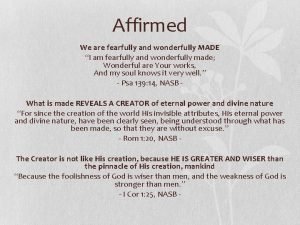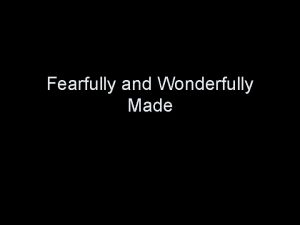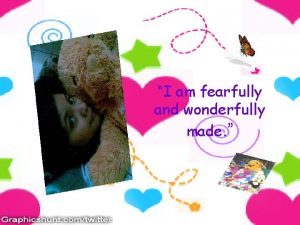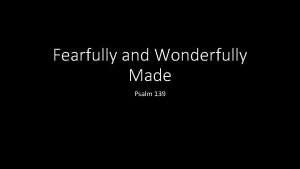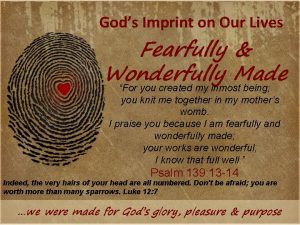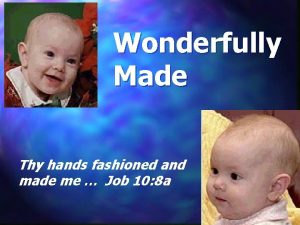Chapter 6 Fearfully and Wonderfully Made The Crown


























- Slides: 26

Chapter 6 Fearfully and Wonderfully Made

The Crown of God’s Creation Man is the most complex of all of God’s creation… Each human body is made of 100 trillion cells… Together, cells contain 60 billion miles of DNA representing 70 trillion gigabytes of information!!! A human heart pumps, on average, a hundred thousand times each day!

The Crown of God’s Creation The human body is far superior to the best machines that modern technology can build… Psalm 139: 14 “I will praise thee; for I am fearfully and wonderfully made; marvelous are your works; and that my soul knows well. ”

The Body Cavities There are four body cavities: 1. Cranial cavity – brain 2. Spinal cavity – spinal cord 3. Thoracic cavity – heart, lungs, esophagus, windpipe, thymus gland, and aorta 4. Abdominal cavity – liver, stomach, pancreas, spleen, kidneys, urinary bladder, small and large intestine, reproductive organs (gonads) All soft, internal organs are called “visceral organs”

Body Systems A system is a group of structures which function together as a unit to perform a definite job for the body. Each system is divided into smaller units called organs… Organs are divided into tissues… Tissues are divided into cells…

Body Systems Division in body systems: Body Systems ↓ Organs ↓ Tissues ↓ Cells

Body Systems There are eleven body systems: 1. 2. 3. 4. 5. 6. 7. 8. 9. 10. 11. Circulatory System Immune System Respiratory System Digestive System Excretory System Nervous System Endocrine System Integumentary System Skeletal System Muscular System Reproductive System

The Circulatory System The organs include: Heart Arteries Veins Capillaries Arteries carry blood away from the heart Veins carry blood to the heart

Immune System It protects the body from viruses and bacteria… Includes: White blood cells Lymph nodes – where the white blood cells filter out the viruses and bacterial poisons Bone Marrow – where white blood cells are produced Spleen Tonsils

Respiratory System Supplies the body (cells) with oxygen… Includes: Nose Nasal Passages Pharynx Larynx Trachea Bronchial tubes Lungs Carbon dioxide and oxygen pass between the blood and air through the alveoli (air sacs) in the lungs…

Digestive System The digestive system makes up a 20 foot long tube… Begins in the mouth with digestive enzymes… Ends with the anus…

Excretory System Provides openings on the body to excrete a variety of waste materials… Includes: Sweat glands Kidneys (filter blood) Urinary Bladder (collects waste from kidneys) Urethra (connects bladder to outside of body)

Nervous System Coordinates the activities of the body… Includes: Sense organs – sight, hearing, smell, taste, touch, pressure, and pain. Brain and spinal cord

Endocrine System Controls activities of the body through chemical “messages”… Includes: Endocrine glands that produce hormones that control growth and digestion…

Integumentary System Protects the body from its surroundings… Includes: The Skin

Skeletal System Provides support and rigidity to the body… Includes: The 206 bones of the body…

Muscular System Provides movement for the body… Includes: Voluntary muscles – consciously controlled Involuntary muscles – not controlled Cardiac muscle - heart

Reproductive System Keeps the human race going… Humans begin at conception – when a sperm unites with an egg…

Tissues Remember…each organ is made up of a type of tissue… There are four types of tissues: 1. Epithelial 2. Connective 3. Muscle 4. Nerve

Epithelial Tissue • • Lines all the body parts Covers and protects every organ Manufactures and secretes lubricants Some has Cilia

Nerve Tissues • Controls organs and coordinates all their functions…

Muscle Tissue • Moves the body and parts

Connective Tissue • Connects the parts of the body • Make up bone and support the body • Tendons and ligaments hold muscles and bones together • Blood is a liquid connective tissue • Fat – protects organs and stores energy

Tissue Fluids • • You are 66% water Much of the water is found in body fluids Including blood and cerebrospinal fluid Includes interstitial fluid – fluid surrounding tissues

Membranes Four basic types: 1. Serous Membranes – serve as lining for enclosed body cavities 2. Mucous Membranes – Epithelial tissue which line openings to outside – throat, mouth, nose 3. Cutaneous Membrane – Skin 4. Synovial Membrane – lining of joints

Cells and Matrix • Tissues are made up of individual cells and matrix • Matrix is the material surrounding cells • The matrix of bone tissue includes materials in which calcium is stored • The matrix of blood tissue is plasma
 Fearfully and wonderfully made verse meaning
Fearfully and wonderfully made verse meaning I am fearfully and wonderfully made
I am fearfully and wonderfully made What part of speech is the word proudly
What part of speech is the word proudly Hát kết hợp bộ gõ cơ thể
Hát kết hợp bộ gõ cơ thể Ng-html
Ng-html Bổ thể
Bổ thể Tỉ lệ cơ thể trẻ em
Tỉ lệ cơ thể trẻ em Voi kéo gỗ như thế nào
Voi kéo gỗ như thế nào Glasgow thang điểm
Glasgow thang điểm Chúa sống lại
Chúa sống lại Kể tên các môn thể thao
Kể tên các môn thể thao Thế nào là hệ số cao nhất
Thế nào là hệ số cao nhất Các châu lục và đại dương trên thế giới
Các châu lục và đại dương trên thế giới Cong thức tính động năng
Cong thức tính động năng Trời xanh đây là của chúng ta thể thơ
Trời xanh đây là của chúng ta thể thơ Mật thư tọa độ 5x5
Mật thư tọa độ 5x5 Phép trừ bù
Phép trừ bù độ dài liên kết
độ dài liên kết Các châu lục và đại dương trên thế giới
Các châu lục và đại dương trên thế giới Thể thơ truyền thống
Thể thơ truyền thống Quá trình desamine hóa có thể tạo ra
Quá trình desamine hóa có thể tạo ra Một số thể thơ truyền thống
Một số thể thơ truyền thống Cái miệng nó xinh thế chỉ nói điều hay thôi
Cái miệng nó xinh thế chỉ nói điều hay thôi Vẽ hình chiếu vuông góc của vật thể sau
Vẽ hình chiếu vuông góc của vật thể sau Biện pháp chống mỏi cơ
Biện pháp chống mỏi cơ đặc điểm cơ thể của người tối cổ
đặc điểm cơ thể của người tối cổ Ví dụ về giọng cùng tên
Ví dụ về giọng cùng tên






























